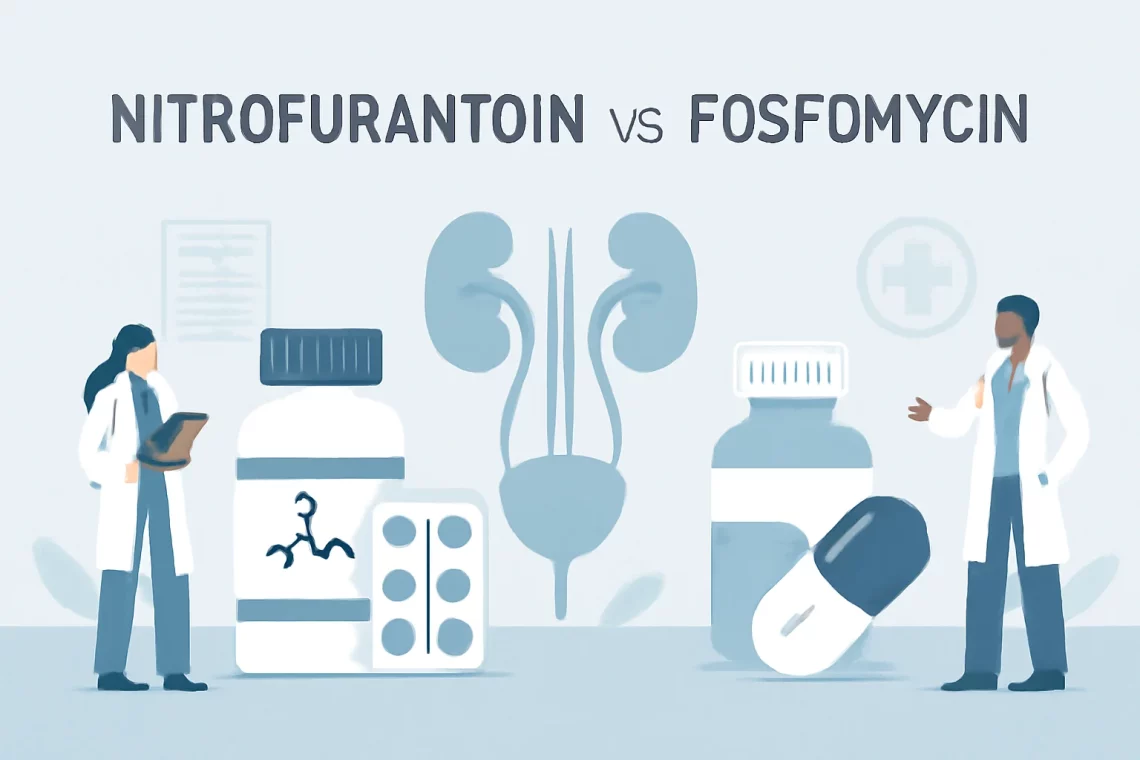
Comparing Nitrofurantoin and Fosfomycin for Urinary Tract Infections
Nitrofurantoin and fosfomycin are two antibiotics commonly used to treat urinary tract infections (UTIs). Both medications have unique mechanisms of action and various indications for use, making them valuable options in the realm of antimicrobial therapy. With the increasing prevalence of antibiotic resistance, understanding the differences between these two drugs is crucial for both healthcare providers and patients. Factors such as efficacy, side effects, dosage, and patient-specific considerations play a significant role in determining which antibiotic may be more appropriate for a given situation. As urinary tract infections continue to affect millions of individuals worldwide, the choice between nitrofurantoin and fosfomycin remains a relevant topic in modern medicine.
In the following sections, we will explore the distinct characteristics of nitrofurantoin and fosfomycin, emphasizing their mechanisms of action, clinical uses, and potential side effects. By gaining a deeper understanding of these antibiotics, we can make more informed decisions regarding their use in treating urinary tract infections and other related conditions.
Mechanisms of Action
Nitrofurantoin and fosfomycin operate through different mechanisms to exert their antibacterial effects. Nitrofurantoin, a nitrofuran derivative, primarily works by inhibiting bacterial enzymes involved in nucleic acid synthesis. Once inside the bacterial cell, nitrofurantoin is reduced to reactive intermediates that damage bacterial DNA and RNA, leading to cell death. This unique mechanism is particularly effective against a range of Gram-negative and some Gram-positive bacteria, making it a reliable choice for treating uncomplicated UTIs.
Fosfomycin, on the other hand, has a different mode of action. It inhibits bacterial cell wall synthesis by blocking the enzyme MurA, which is essential for the formation of peptidoglycan, a critical component of the bacterial cell wall. This action disrupts the integrity of the bacterial cell wall, ultimately causing cell lysis. Fosfomycin is effective against a variety of pathogens, including E. coli, which is the most common cause of UTIs.
The differences in their mechanisms of action also influence the spectrum of activity for each antibiotic. Nitrofurantoin is particularly effective against E. coli and some strains of Staphylococcus saprophyticus, making it a first-line treatment for uncomplicated UTIs. Fosfomycin, due to its unique action, can target bacteria that may be resistant to other antibiotics, providing an alternative option for treatment.
Understanding these mechanisms is essential for selecting the appropriate antibiotic, especially in an era where antibiotic resistance is a growing concern. The choice between nitrofurantoin and fosfomycin may depend on the specific bacteria causing the infection, the patient’s medical history, and any potential allergies to these medications.
Clinical Uses
Both nitrofurantoin and fosfomycin are primarily indicated for the treatment of urinary tract infections, but their clinical uses extend beyond this condition. Nitrofurantoin is often prescribed for uncomplicated cystitis, which is an infection of the bladder that typically presents with symptoms such as frequent urination, urgency, and discomfort. Due to its effectiveness against common UTI pathogens, it is frequently recommended as a first-line treatment option.
In addition to uncomplicated UTIs, nitrofurantoin may also be used for prophylactic purposes in patients with recurrent urinary tract infections. This preventive approach helps to lower the risk of future infections, particularly in individuals who experience frequent UTI episodes. The medication is usually well-tolerated for short-term use and can significantly improve the quality of life for those affected.
Fosfomycin, on the other hand, is often reserved for cases where patients may have allergies to other antibiotics or when there is concern about antibiotic resistance. It is particularly useful in treating uncomplicated UTIs caused by multidrug-resistant organisms. Fosfomycin is also available in a single-dose formulation, which can enhance patient compliance and convenience, making it an attractive option for outpatient treatment.
Both medications can be effective, but the choice between them may depend on a variety of factors, including the patient’s specific infection, history of antibiotic use, and any contraindications. It is essential for healthcare providers to carefully consider these factors to ensure that patients receive the most appropriate treatment for their condition.
Side Effects and Considerations
As with any medication, nitrofurantoin and fosfomycin have potential side effects that should be considered when prescribing these antibiotics. Nitrofurantoin is generally well-tolerated; however, some patients may experience gastrointestinal disturbances, including nausea, vomiting, and diarrhea. Additionally, nitrofurantoin can cause pulmonary reactions, particularly with long-term use, leading to symptoms such as cough, dyspnea, and chest pain. Rarely, it may also cause liver toxicity and peripheral neuropathy, especially in individuals with pre-existing renal impairment.
Fosfomycin’s side effects are typically mild and may include headache, dizziness, and gastrointestinal symptoms. Unlike nitrofurantoin, fosfomycin is less likely to cause significant adverse effects, making it a safer option for many patients. However, it is essential to monitor for allergic reactions or unusual symptoms, as with any medication.
Another important consideration is the renal function of the patient. Nitrofurantoin is contraindicated in individuals with significantly reduced renal function, as it may lead to inadequate drug levels in the urine and increase the risk of toxicity. Fosfomycin, on the other hand, can be used in patients with varying degrees of renal impairment, although dosing adjustments may be necessary.
Ultimately, the decision to use nitrofurantoin or fosfomycin should involve a thorough assessment of the patient’s medical history, current health status, and potential drug interactions. Open communication between the healthcare provider and the patient is crucial to address any concerns and ensure the chosen antibiotic is the most appropriate for the situation.
In conclusion, nitrofurantoin and fosfomycin are valuable antibiotics in the treatment of urinary tract infections. Understanding their mechanisms of action, clinical uses, and potential side effects can aid in making informed treatment decisions. As always, individuals should consult their healthcare provider for personalized medical advice tailored to their specific needs.
**Disclaimer:** This article is for informational purposes only and does not constitute medical advice. Always consult with a healthcare professional for any medical concerns or before starting any new treatment.




